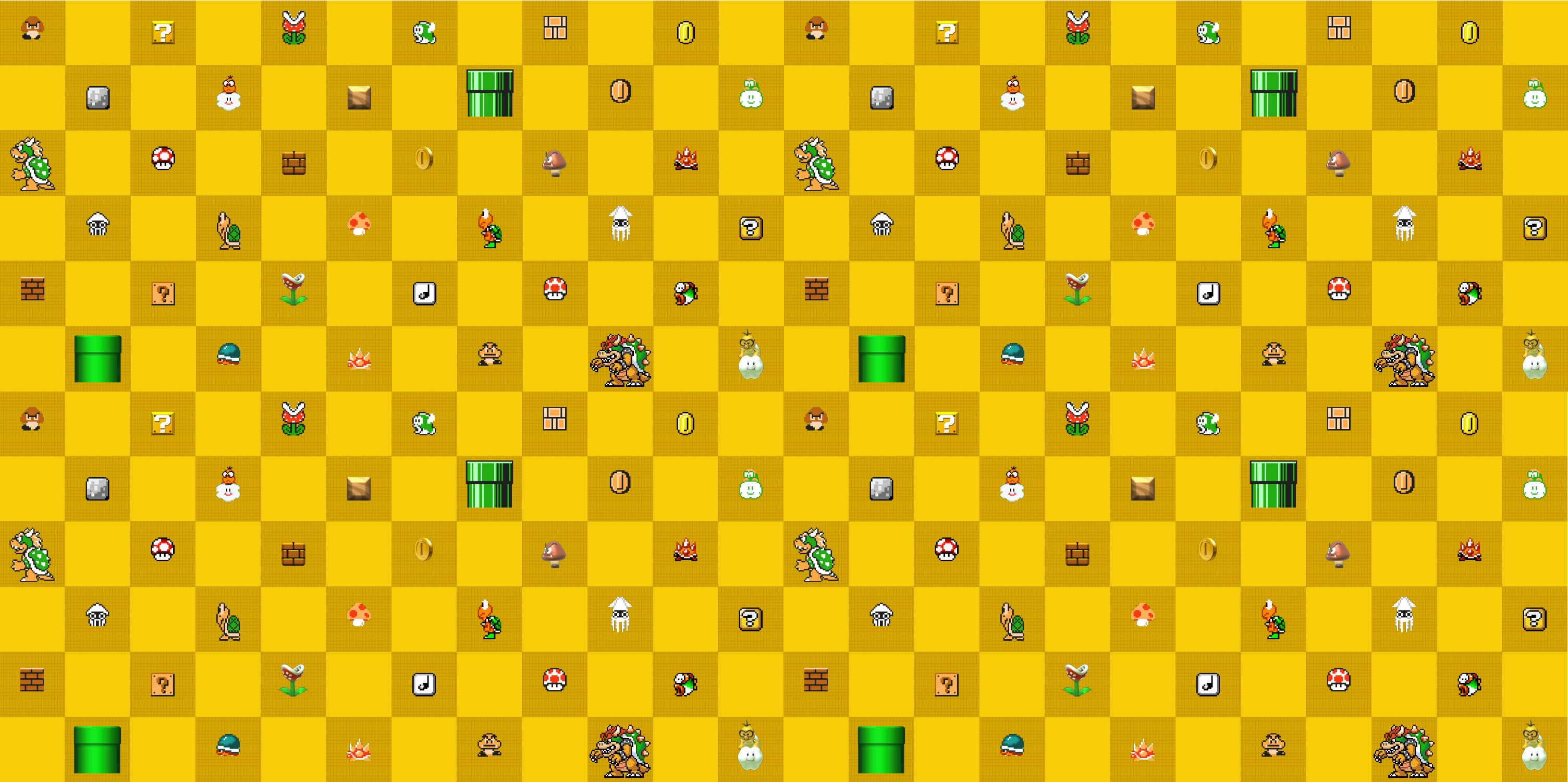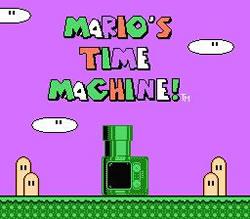|
|
Release dates
General information Platform: Nintendo Entertainment System Developed by Radical Entertainment Published by Nintendo Players: Single player |
||||||||||||
|
|
Release dates
General information Platform: SNES Developed by The Software Toolworks Published by Mindscape Players: Single player |
||||||||||||
|
|
Release dates
General information Platform: Personal Computer (PC) Developed by The Software Toolworks Published by Mindscape Players: Single player |
on
![]() Buy Mario's Time Machine
Buy Mario's Time Machine
on
![]()
Quick links: Overview / Story / Gameplay & Object / Time Periods / Videos: Trailers, Commercials & Gameplay / References to other Mario games / Reception & Sales / Trivia & Facts / Reference & Information / Media
Overview
Mario’s Time Machine is an
educational video game developed and produced for multiple platforms (MS-DOS,
NES and
SNES consoles). It was
originally released for MS-DOS and after that for the later two consoles. The
Software Toolworks was in charge of the MS-DOS and SNES versions of the game
(they were both published in 1993), while Radical Entertainment developed the NES version, and its publisher was
Nintendo itself
(the game came out in 1994). The MS-DOS version of the game was rereleased in
1996 under the name – Mario’s Time Machine Deluxe. The PC version of the game
was distributed via floppy disks, while Mario’s Time Machine Deluxe came in a
form of a CD-ROM. It had voice acting added on, as well as a reference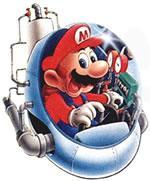 file that
featured
Bowser’s mother.
file that
featured
Bowser’s mother.
This was one of the several Mario educational games that were released in the
90s. Needless to say, all of them received quite negative critics from both the
media and the gaming community itself. Educational games are a very unpopular
genre for the industry, and even though developers gave their best effort into
this game (as well as the other Mario educational games like
Mario is Missing!
and
Mario’s Early Years!), it couldn’t escape the fate of other educational
games and that is a collapse on the market. This title holds an aggregate score
of 60.25% on GameRankings
based on two reviews, and it is compared to another similar educational game
called
Where in Time is Carmen Sandiego?
Story
The storyline of the game is pretty
basic and simple – Mario’s arch-nemesis Bowser (who else?) is up to no good yet
again, and this time with the help of a time machine that he developed. He uses
this time machine to travel back to different significant historical points in
order to steal various artifacts and keep them in his own personal museum inside
his castle. Mario soon learns about his intentions and realizes that history
will change forever if he does nothing, so it is up to him to stop Bowser yet
again. So yeah, as you can guess………..the educational role of this game is to
teach you some history.
There are some differences in the plot between different versions of the game,
though. For example, both the NES and the SNES versions of the game add that
Bowser has intentions to destroy his time machine (that is referred to as
Timulator in the manuals), in order to permanently change history and send the
world back to the Dark Ages. In the NES version, Bowser’s Museum is already
fully built and it is equipped with the greatest historical artifacts. Yoshi
joins Mario in order to stop him, but he is captured and taken as a prisoner
while he is scouting ahead. So, in addition to the original storyline, Mario
also has to save Yoshi.

Official story from the SNES version of the instruction booklet.
Better check your watch! Bowser's out to turn back the clock. Not to Daylight Savings. No! To the Dark Ages!
That terrible turtle is using a time machine, called a Timulator, to loot historical artefacts from the past. His twisted intent? To build Bowser's Museum, fill it with historic booty, then destroy the time machine. This dastardly plan will turn time inside out, make the future bend over backwards, and change the course of history. Forever.
This is no time to let bygones be bygones. Help Mario stop Bowser before he warps time and puts hiccups in history. If not, it's back to stone tools and hieroglyphics! This quest is hot. If you're too late, it'll be lights out. Time's up.
The NES version of the instruction booklet contains the same story.
As for the PC version, the manual (the manual that doesn't seem to exist) doesn't contain a story. It was merely an insert in the jewel case telling you how to install the game, however the opening dialog of the Deluxe edition acts as it's back story of the PC version:-
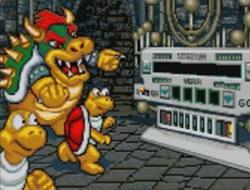
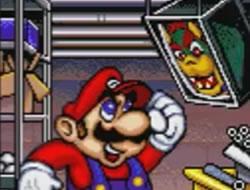
Bowser: It's time, my cunning koopas, to use the time machine and steal the most valuable artifacts that history has to offer...
Bowser: Mario, my collection is almost complete ... and there's not a thing that you can do to stop me!
Mario: Bowsers museum is inside his castle, I have to get in there and return all the stolen artifacts before history is changed forever!
Mario: At last, Bowsers castle! I'll show that no good reptile! he can't mess with history, as long as I'm around to set things right!
Bowser: The greatest collection of ALL time is nearly complete and it's all mine! No one can stop me now! Not even Mario!
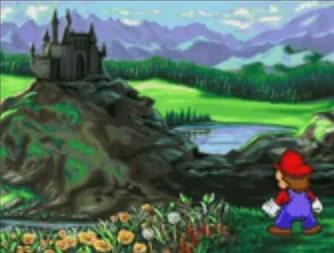
And so it begins.
Gameplay & Object of the Game
As it was already mentioned in the
previous section, the objective of the game is to return the historical
artifacts to their proper time periods, and this is mutual for all 3 versions of
the game. However, the overall gameplay varies between the 3 versions, so we
will divide this section into 3 different parts and describe the gameplay for
each of them:
MS-DOS version
The central hub in this game is the museum inside Bowser’s castle. It has 3
floors and each of them has 5 artifacts to be found. You need to take the
artifact from a pedestal, look at its date and location, and then add that
information into the time machine, in order to access the appropriate time
period.
As soon as you enter a certain time period you need to explore and interact with
various residents of the area in order to get more information about the
artifact, the period itself and the person connected to it. To do so, you must
get the items from certain residents and give them to others, in order to
satisfy their needs. After you speak with everyone, you will automatically fill
out a History answer sheet (it is a two-page biography about the person who is
connected to the artifact and the time period, and it has some blanks which
replace certain words). You must use the information that you have acquired in
order to correctly fill out the blanks. If you miss the correct answer 3 times
(or more), you will return to the present time, and you will be forced to play
through the same time period from the beginning. However, if you manage to get
the correct answer, you can return the artifact to its owner and return back to
the present time, having the mission accomplished. Once you get all the
artifacts on a certain floor, you automatically advance to the next one.
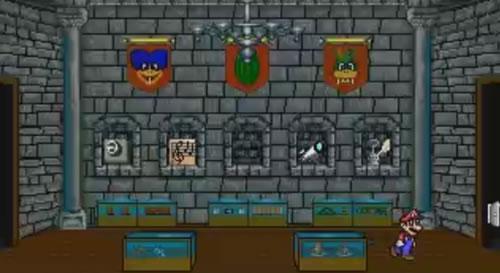
A hidden checklist as well as a timer are both used in the game. How long you
spend in each of the time periods, and the order in which you acquire the
artifacts all trigger one of several different endings of the game (there are 3
of them, in total). If you spend too much time to return the artifacts and/or if
you return even one of the artifacts in the wrong order, Bowser manages to
escape to Paradise (a tropical island first and last seen in this game), or he
gets teleported to the Cretaceous period, where he looks confused and waves his
head all over the screen. Also, a message that reminds you to return the
artifacts to their correct order appears as well. Basically, you must start over
from the beginning, or you can use a password to go back to the preceding point.
In case you meet the 2 objective conditions, the time machine will overload and
it will destroy itself, sending Bowser to the Cretaceous period, only for him to
get stomped by a Tyrannosaurus Rex.
SNES version
As this is, basically, a port of the original game it has some changes. The
amount of overall content is much lower so, automatically, that means that there
is a smaller number of time periods as well. There are some changes in terms of
the overall design of the time machine as well. On time’s waves, you can move in
all directions, and not just forward, thanks to the
SNES’ Mode 7, which is an
improvement from the original game.
NES version
Unlike its predecessor (Mario is Missing!), this is a completely different game
and overall experience than the previous 2 versions, as neither do you travel to
the same time periods as in the MS-DOS and the SNES versions of the game, nor do
you restore the same artifacts either. Bowser’s castle is a hall that consists
of seven chambers, and at the end of it there is Bowser’s chamber. Behind each
of these doors, there is a mini-game that resembles the Mario Bros. style of
gameplay. It involves beating the Koopa Troopas and getting a special item in
case you manage to beat all of them. The Timulator is located in the bottom
centre of each room, and it is a typical elevator-pipe with a transparent box
added on. Inside the Timulator, you can select time periods in a linear fashion
(you can’t access them manually like in the previous 2 versions). Once you enter
a certain time period, you will see short platforming elements with some enemies
and, often, indigenous inhabitants of that time period as well. There are some
message blocks scattered across the area, and their function is to describe the
entire location. In order to get the item, you must win a mini-game and then
return it to the correct spot. If the spot is not correct, the item will return
to the Koopas, but if you get it right, you will beat the stage. There are 2
artifacts in each of the doors, so you must go through each of the doors at
least twice in order to close that part of the museum. After all doors of the
museum are closed, a deeper part of the castle becomes available as soon as you
pass a history test about what you have learned until that point (what is this,
school?). After you defeat Bowser, Mario acquires the key and he releases Yoshi
from the cage. The ending sequence has both Mario and Yoshi posing next to a sad
and crying Bowser.
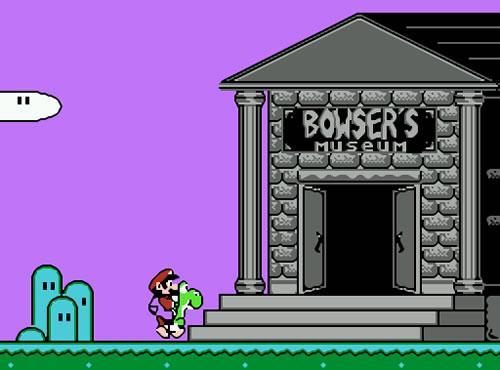
Bowser and his koopas have built the greatest museum in history, but to do it they have stolen many important items from the past.
Time Periods
As much as the gameplay varies between the 3 versions of this game, it should be noted that time periods in all these versions are also different, and that should be no surprise knowing all of the circumstances. In this section you can find out what time periods you will encounter in each of the 3 different releases of this game:
MS-DOS version
369 BC — Athens (Plato's book, The Republic)
47 BC — Alexandria (Cleopatra's Royal Staff)
105 AD — Luoyang (T'sai Lun's Bamboo)
1292 — Gobi Desert (Marco Polo's Printing Block)
1429 — Orleans (Joan of Arc's Shield)
1455 — Mainz (Johann Gutenburg's Printing Machine)
1503 — Florence (Michaelangelo's Chisel)
1505 — Florence (Leonardo Da Vinci's Papers)
1521 — Pacific Ocean (Ferdinand Magellen's Astrolabe)
1595 — London (Crown of Queen Elizabeth I of England)
1601 — Stratford-Upon-Avon (William Shakespeare's Skull)
1610 — Padua (Galileo's Telescope)
1687 — Cambridge (Sir Isaac Newton's Apple)
1752 — Philadelphia (Benjamin Franklin's Key)
1776 — Philadelphia (Thomas Jefferson's Declaration of Independence)
1791 — Vienna (Wolfgang Mozart's Flute)
1824 — Vienna (Ludwig van Beethoven's Music Sheet)
1831 — London (Michael Faraday's Magnet)
1843 — London (Charles Dickens' Inkwell)
1863 — Washington (Abraham Lincoln's Glasses)
1879 — Menlo Park (Thomas Edison's Filament)
1885 — Paris (Louis Pasteur's Flask)
1915 — Tuskegee (George Washington Carver's Crank Handle)
1947 — Calcutta (Mahatma Gandhi's Indian Flag)
1994 — Novato (Software Toolworks' Floppy Disk)
SNES version
369 BC — Athens (The Republic)
47 BC — Alexandria (Cleopatra's Royal Staff)
1292 — Gobi Desert (Marco Polo's Printing Block)
1429 — Orleans (Joan of Arc's Shield)
1455 — Mainz (Gutenberg's Printing Machine)
1503 — Florence (Michelangelo's Chisel)
1505 — Florence (Da Vinci's Papers)
1521 — Pacific Ocean (Magellan's Globe)
1595 — England (Elizabeth I's Crown)
1601 — Stratford upon Avon (Shakespeare's Skull)
1687 — Cambridge (Newton's Apple)
1776 — Philadelphia (Declaration of Independence)
1824 — Vienna (Beethoven's Music Sheet)
1879 — Menlo Park (Edison's Filament)
1947 — Calcutta (Gandhi's Indian Flag)
NES version
80M BC — Prehistoric dinosaur egg
776 BC — Olympic torch
31 BC — Marc Antony's throne
1192 — Crusader's sword
1520 — Magellan's steering wheel
1602 — Shakespeare's quill pen
1687 — Newton's apple
1862 — Lincoln's stovepipe hat
1879 — Edison's light bulb
1903 — Wright Brothers' propeller
1905 — Einstein's physics equation
1947 — Gandhi's Indian flag
1969 — Armstrong's U.S. flag
1989 — Sledgehammer that destroyed the Berlin Wall
Videos: Trailers, Commercials & Gameplay
The Ending from the NES version of Mario's Time Machine.
The slow-completion ending from the PC version (if you weren't quick enough for the next ending shown beneath)
The optimal ending for the PC version of Mario's Time Machine.
A full playthrough of the NES version of Mario's Time Machine.
References to other Mario games
Even though not as successful and popular as most of the other games from the franchise, it still brought some elements that had their references in the other Mario titles. Which elements? And which games? You will now find out…..
-
Mario Bros. – A way of collecting objects in the NES version of the game involves beating 3 Koopa Troopas in a similar manner to the style used in this game. Unlike in the original game, in this one Mario can enter the pipes, and they can also be used to access the main part of the museum
-
Super Mario Bros. 3 – A sprite of Bowser from the NES version of the game is basically a modified version of the same sprite from this title
-
Super Mario World – Most of the sprites from the NES version of the game (including the ones for Mario, Yoshi and the Koopas) are those from this game, with the exception that they are modified for an 8-bit system. A number of additional elements also directly reference this game. For example, the opening sequence where Mario and Yoshi walk up to Bowser’s museum is the same as the sequence before Mario enters Ghost Town or the Castle, with the exception that Yoshi runs inside the museum after Mario gets off his back, instead of waiting for him outside
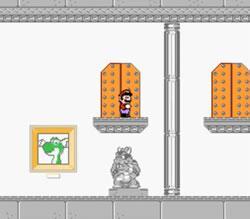
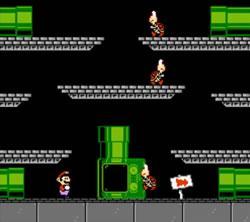
Mario using a recoloured version of the Bowser's door sprites from Super Mario World & the Bowser sprite from SMB3 (left screenshot), and the full setup of the original Mario Bros (right screenshot). I actually think some real effort went into designing some of these levels.
Reception & Sales
Since the game was officially
released, it has received mixed reviews, although the negative ones are
dominating. It has an aggregate score of 60.25% on
GameRankings based on 2
reviews. GamePro praised its dialogues with various historical figures, stating
that “the scenarios make flesh-and blood human beings out of people who are
usually just static pictures in textbooks”. Their critics were focused on the
Timulator controls (they called them “too confusing, especially for the game’s
targeted age group”, but still their summary was that the game was both
educational and enjoyable at the same time. On the other hand,
Nintendo Power
gave it a mark of 2.65 (out of 5), while
Electronic Gaming Monthly liked the
game better, and they gave it 6.75 out of 10.
Two reviewers from GameSpy (Brian Altano and Brian Miggels) stated that the
ending of the game is one of the worst ones ever seen in a video game, and they
criticized it for showing Bowser crying. Another editor of GameSpy (Mike Drucker)
described the whole game with a single line: “half-assed”. GameRadar concluded
that those who like this game may as well like Night at the Museum: Battle of
the Smithsonian, a game that got a bad review from them. They also added that it
is an unpopular game and that “five, maybe six people played the NES version of
Mario’s Time Machine”. ABC Good Game stated that the game is awful and added
that its concept is way too complicated for any school-aged youngster to
understand. Nintendo of Canada included a sealed copy of the NES version of the
game as part of a charity auction, along with several other NES games (they were
also sealed). In the book Video Games: A Guide for Savvy Parents, author called
David Sheff stated that he liked the educational side of the game, but he
criticized the gameplay. Andy Slaven, author of Video Game Bible accused the
game of ripping off the elements from
Where in time is Carmen Sandiego?, also
adding that, although it isn’t a bad game, it is not a good educational one
either.
Authors Gloria Basczak and David Wesley associated this game with the “flood of
ill-conceived Mario spin-offs”, adding that these games almost destroyed the
whole franchise. Janet Swift of The Independent wrote about this game in her
article about the latest generation of educational titles in 1994. She compared
it to its prequel (Mario is Missing!), and she stated that it has an educational
value for children. She praised its execution and she called it “special”. Brett
Allan Weiss of Allgame called the action scenes from this game “dreadfully
dull”, and the presentation was “merely average”. He said that while he doesn’t
have anything against educational games, they need to be both “entertaining and
enlightening” in order to win the hearts of its players. IGN’s editor Levi
Buchanan included it in the assessment of the “other Mario games”, adding that
the whole premise is boring and that the game lacks any real platform gameplay.
He said that it had “honorable intentions” but that the whole realization was
“decidedly shallow”. He also complained about the whole idea of putting Mario in
realistic historical time periods, saying that he “occupies the imagination, a
place with Star Festivals and giant piranha plants ”.
The game was also considered as one of the worst Mario games ever released by
many people from the gamming community and many players themselves as well. That
is why it is often found on top-lists of worst Mario games ever (both the lists
that were made by official gaming companies and/or websites and those that are
fan-made). For example, on Screwattack’s list of “Top 10 Worst Mario Games”,
Mario’s Time Machine was put on spot #4. This line perfectly describes what they
think of the game: “Nintendo, please take this concept, re-do it and make it the
way it should be done…not crappy!”
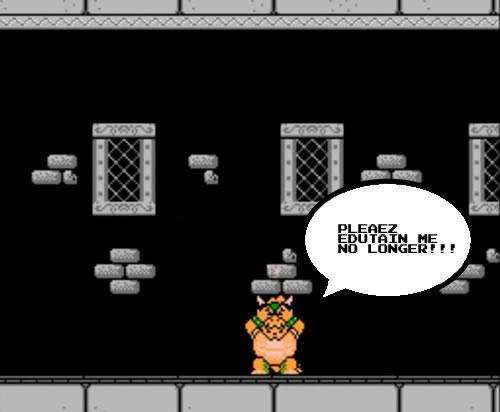
Looks like Bowser could take no
more.
Trivia & Facts
-
One of the first educational or "Edutainment" titles
-
Intended to teach basic history
-
Fifteen periods of time to travel to and between
-
Like in "Mario is Missing", Mario cannot die.
-
This game was released on the NES, SNES, and PC for MS-DOS.
Reference / Information
-
Mario's Time Machine - Credits (NES/SNES)
-
Mario's Time Machine - Ending (NES and SNES)
Media / Downloads

